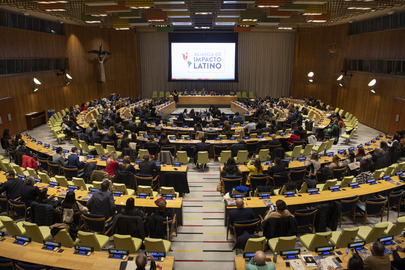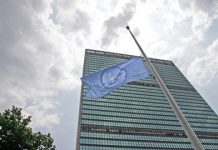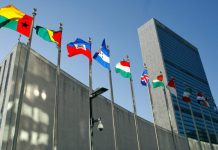FAO warns of avian influenza surge in Asia-Pacific, urges regional action
The UN Food and Agriculture Organization sounded the alarm on Thursday about a surge in avian influenza in the Asia-Pacific region.
Since late last year, 13 people have contracted the virus in Cambodia, with further outbreaks in China and Vietnam – after a period of minimal human infection.
A new highly infectious strain has also emerged – FAO said – and it’s presenting a new challenge for scientists and public health authorities. The H5N1 bird flu virus has already spread further than ever before, reaching South America and Antarctica and infecting new wild and domestic animals.
In March this year, it spread to dairy cows in the United States for the first time, raising concerns about its spread to humans.
Thailand and Myanmar are now at risk, whilst India, Nepal and Bangladesh are already battling outbreaks. With limited biosecurity, the Greater Mekong Subregion, Indonesia and the Philippines are also under the spotlight, said FAO , which issued an urgent call for regional coordination to tackle the “deeply worrying” disease spread.
Kachen Wongsathapornchai, Regional Manager of FAO’s Emergency Centre for Transboundary Animal Diseases (ECTAD) said the new strain has increased the pandemic risk and “immediate, coordinated preventive measures are essential”.
FAO is calling on Member Countries to put in place comprehensive surveillance systems, including genome sequencing to track the virus, rapid diagnostics and cross-sectoral data sharing. Governments, international organizations and the private sector must share information quickly to plan containment strategies. Biosafety and biosecurity in the poultry industry must be strengthened and public awareness raised to reduce transmission risk.
With support from the US Agency for International Development (USAID) FAO is working with 13 countries in Asia and the Pacific to prevent, detect and respond to health threats.
Gaza: Hunger fears persist as Israeli operations further harm enclave’s farmers
The UN’s aid coordination office, OCHA, has issued a stark warning about hunger in Gaza, saying aid isn’t reaching those who need it. Insecurity, damaged roads and access restrictions are severely impeding aid delivery between Kerem Shalom Crossing, Khan Younis and Deir al Balah,” the UN agency said.
Fuel and aid shortages are affecting six bakeries in northern Gaza, leaving them operational for only a few days. Community kitchens face critical shortages leaving them unable to produce enough hot meals for the displaced. A lack of commercial supply shortages has also led to a severe protein shortage in local markets.
Only a few vegetables are available in northern Gaza and at unaffordable prices. The agricultural sector is devastated, and farms and fields are abandoned. Missing the next agricultural season will ruin livelihoods, OCHA said.
Meanwhile, the UN Food and Agriculture Organization (FAO) reports that agriculture in the Gaza Strip covers over 40 per cent of the enclave and supplies up to 30 per cent of its daily food. Hostilities have destroyed this sector, stopped local production of fresh and nutritious food and reduced access to essential items for a healthy diet. 96 per cent of the population of Gaza, about 2.15 million people, are facing acute food insecurity or higher.
Europe tops the charts for alcohol consumption. WHO calls for urgent action to curb the trend
It seems that Europeans don’t want to give up booze…
A UN World Health Organization (WHO) report has found that nothing has changed in the continent’s drinking habits. Despite the health risks, Europeans consume an average of 9.2 litres of pure alcohol a year – making them the world’s biggest drinkers.
WHO’s Dr Gauden Galea said that the impacts are far-reaching including domestic violence, accidents and mental health issues. He called on countries to implement effective policies to reduce drinking.
The numbers tell a sobering story: men in the region drink nearly four times more than women and 470 million people are (missing word)drinkers according to latest data. Two out of every three adults drink, one in 10 has an alcohol use disorder and almost six per cent live with alcohol dependence. Yet only 12 out of 53 countries have made progress in reducing consumption by 10 per cent since 2010.
The report warned that alcohol is the leading cause of death in Europe, accounting for almost 800,000 deaths a year; 2,200 people die daily from alcohol-related causes, almost nine per cent of all deaths in the region.
Despite the clear evidence of harm, many European countries are not implementing the WHO recommendations which include increasing alcohol taxes, restricting marketing and reducing availability.
Lithuania, Latvia and Estonia have shown that population-level control policies can reduce consumption, harm and increase life expectancy.
The WHO urged countries to act now to meet Sustainable Development Goals on health and limit commercial interests that promotedrinking alcohol. Implementing the “Best Buys” and other evidence-based strategies can significantly reduce alcohol-related diseases, deaths, disabilities and injuries, it said.
Music composed and produced by Joachim Harris. All rights reserved
Source of original article: United Nations (news.un.org). Photo credit: UN. The content of this article does not necessarily reflect the views or opinion of Global Diaspora News (www.globaldiasporanews.com).
To submit your press release: (https://www.globaldiasporanews.com/pr).
To advertise on Global Diaspora News: (www.globaldiasporanews.com/ads).
Sign up to Global Diaspora News newsletter (https://www.globaldiasporanews.com/newsletter/) to start receiving updates and opportunities directly in your email inbox for free.






























